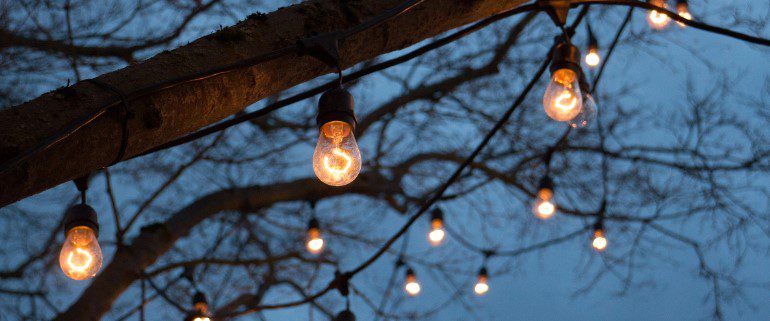For years, the trend in outdoor lighting has been “see the light, not the fixture.” Nowhere is this more apparent than in artfully designed and skillfully installed downlighting. Many homes have some amount of downlighting already installed. Often this is in the form of simple fixtures under gutters, soffits, or some other type of overhang. These lights typically light up the side of the house with an attractive cone of light. While they are often quite attractive, they do little to light the area around your home and are definitely not natural-looking. This article will discuss another type of downlighting, using outdoor downlighting to mimic nature.
![Using Outdoor Downlighting to Mimic Nature [infographic]](https://nvlightingga.com/wp-content/uploads/2018/10/Using-Outdoor-Downlighting-to-Mimic-Nature-infographic-1.png)
How Downlighting Is Different?
Outdoor lighting designers have many choices when it comes to how they want to light an area or a feature. We often install uplighting under a particularly spectacular tree or other feature to highlight its beauty. We use wash lighting to gently light up the facade of your home. Path lighting is another important part of any lighting scheme, both for its beauty and its practicality.
Sometimes we use well lights to provide great uplighting while completely hiding the fixture.
Downlighting is different. Downlighting is typically not installed to light a particular feature or pathway. Instead, downlighting is used to illuminate a broad area, and as such, the goal is to look as natural as possible. Of course, at night, there is only one genuinely natural source of light, and that is the moon. So when it comes to natural-looking downlighting, our main inspiration is the beautiful light of a full moon on a clear summer night.
What Does Moonlight Look Like?
What does moonlight look like? This is a deceptively simple question. We all know what moonlight looks like. At least, we think we do. But the fact is, if you asked someone to really describe moonlight, they might be hard-pressed to find a reasonable answer. One thing most people will tell you is that moonlight is “silver.” This makes a certain amount of sense. When we look up at a full moon, it is usually silver in color. But the light of the moon is just the light of the sun reflected, so moonlight is actually white, like the light of the sun. But the silvery appearance of moonlight isn’t entirely untrue. It’s not real, but it’s not untrue. Instead, it is an optical illusion of sorts.

The Purkinje Effect
The effect that makes moonlight appear silvery or blue is called the Purkinje effect, and it is actually a result of the way our eyes see. The parts of our eyes that actually detect light are called photoreceptors. These are specialized cells that are activated by light and send signals to the brain. There are two types of photoreceptors, rods and cones. The cones are able to perceive color, but they require much more light than rods to be activated. They are used in daylight conditions to provide a sharp color image of the world around us. Rods, on the other, see only light and dark without any information about color. But they are activated by only a very small amount of light. We use rods to see in the dark, which is why humans are basically colorblind in very low-light conditions.
One important difference between rods and cones is the type of light that they are sensitive to. Cones, our bright light receptors, are most sensitive to orange-yellow light. Rods are most sensitive to blue light. In dim light, such as moonlight, our color vision has not entirely disappeared, but the rods are becoming more active. This gives the impression that there is more blue light, even though the actual spectrum of light remains the same.
Simulating Moonlight
The only natural light at night comes from the moon. So the most natural outdoor lighting is light that mimics moonlight. There are two factors to simulating moonlight. There is the color of the light (as indicated by the Purkinje effect) and the way the light hits the ground.
To simulate the Purkinje effect, outdoor downlighting often uses lights in the 4,100K range or slightly less. This is slightly bluer than standard indoor lighting, which is usually around 3,000K. Of course, simply keeping the light dim will also activate the actual Purkinje effect. For this reason, it is important not to overdo the blue shift. A light that is too blue looks unnatural and even tacky.
The second factor in simulating moonlight is the way the light hits the ground. Often, we think of moonlight as dappled. That’s just a simple way of saying that moonlight has to go through trees, brush, and anything else above our heads before it gets to us. So the light is not even. Instead, there are areas of brighter and dimmer light. To get this effect with artificial downlighting, lights must be placed high up in trees. Depending on the size of the tree, the lights could be placed twenty, thirty, or even 40 feet up.
To figure out the best placement for downlighting, look about twenty feet up the trunk of the tree. That is the minimum height that will give you a natural effect. From there, follow the trunk up another ten feet or so. This is a more optimal mounting location. To get the perfect spot, try to estimate where the lights will shine through enough branches and leaves to get a dappled look without obscuring the light too much.
Downlighting Fixtures
The type of fixtures you use for downlighting is just as important as the color and placement. The wrong type of fixture can produce an effect that is not natural at all, as we will discuss. Many manufacturers build fixtures specifically for mounting in trees or specifically for moonlighting. These are typically the best fixtures to use, although there are other fixtures that are suitable.
The primary concern with natural downlighting is that the light is directed downward and only downward. Allowing the light to spread horizontally would result in a very unnatural glowing tree canopy. Also, because these lights are placed so high up, they are in danger of creating light pollution or light trespass. Light trespass is when the lighting on your property trespasses into your neighbor’s property. To avoid this, use fixtures that are fitted with glare-reducing guards or sheaths.
The type of fixture you use will also determine the spacing of your fixtures. The goal of natural downlighting is to provide an even light across the area you are lighting without pronounced cones of light. To do this, you will need to calculate how much area is covered by each fixture. A fixture mounted 20 feet up a tree with a 60º lamp will create a cone of light with a diameter of about 20 feet. The calculations involved in figuring out your fixture’s cone size are a bit complicated, but the experts at Night Vision Lighting are well-equipped to help you figure this out. Whatever the size of the area lit by your fixture, you want to make sure that you have enough fixtures to cover the whole area you plan to illuminate.
Installing Natural Downlighting
Natural downlighting is as much an art as it is a science. It helps to know what type of light to use, how to space them, and other numbers that are known or can be calculated. But the art is finding just how to arrange the lights to provide that perfect dappled look with just enough brightness. You could try to do it yourself with a trial and error approach, or you could tap into some serious experience.
Night Vision Outdoor Lighting has completed over 5,000 projects, including lots of downlighting. We can tell where the best place is to put your fixtures to get the perfect light. So before you spend weeks or months installing and uninstalling your downlighting, save yourself some trouble and let the pros handle it. We’re happy to discuss your needs, desires, and budget and to come up with the perfect plan for your property. Don’t wait. Contact us today!
Conclusion
In the realm of outdoor lighting, downlighting has emerged as an artful technique to seamlessly blend illumination with the natural surroundings. While traditional downlight fixtures may provide functional lighting, the focus here is on using outdoor downlighting to mimic the gentle, dappled glow of moonlight. With a nod to the Purkinje effect, we explore the subtle nuances that make moonlight unique and how to recreate this natural ambiance through carefully chosen color temperatures and strategic placement. Let’s delve into the world of simulated moonlight and transform your outdoor space into a captivating haven.
FAQs
How is downlighting different from other outdoor lighting techniques?
Downlighting is distinct in its goal to illuminate broad areas naturally. Unlike uplighting, which highlights specific features, downlighting seeks to mimic the soft, even glow of moonlight across the landscape.
What is the Purkinje effect, and how does it influence moonlight appearance?
The Purkinje effect is the phenomenon where moonlight appears silvery or blue due to the increased sensitivity of rods (light receptors) to blue light in dim conditions. Understanding this effect guides the selection of color temperatures for simulated moonlight.
How is moonlight simulated in outdoor downlighting?
To simulate moonlight, outdoor downlighting often uses lights in the 4,100K range or slightly less. Placement is crucial, with lights mounted high in trees to achieve a dappled effect similar to moonlight filtering through branches and leaves.
What considerations are important for downlighting fixtures?
Downlighting fixtures must direct light downward to create a natural effect. Special fixtures designed for moonlighting or tree mounting are preferable. Glare-reducing guards or sheaths are essential to avoid creating unnatural glowing tree canopies and prevent light trespass.
How is spacing determined for natural downlighting?
Calculating the fixture’s cone size, which is influenced by mounting height and lamp angle, helps determine spacing. The goal is to achieve even light coverage across the intended area without pronounced cones of light.
Why is professional expertise crucial for natural downlighting installations?
Natural downlighting involves both art and science. While knowing the technical aspects is essential, the art lies in arranging lights to create the perfect dappled look. Professionals, like Night Vision Outdoor Lighting, bring experience to optimize fixture placement and achieve the desired lighting effect.
How can one get started with natural downlighting for their property?
Contact Night Vision Outdoor Lighting to discuss your needs, desires, and budget. With over 5,000 completed projects, including downlighting installations, their experts can guide you in creating the perfect plan to transform your outdoor space. Save time and trouble by tapping into their experience for a captivating moonlight-inspired ambiance.



